The methodologies are complementary, have commonalities, require different skills, and should be part of the overall meta-iterations within a concerted digital transformation effort.

It is quite ironic that initiatives and methodologies within the same organization attempting to align strategic objectives to execution are often themselves siloed. We shall focus here on methodologies that are trying to operationalize and realize the most important potential of Digital Transformation (DX): Intelligent Automation (IA). We will abbreviate it as DX IA. IA is achieved through Digital Process Automation.
The four methodologies discussed in this article are quite complementary. There are commonalities, but they do require different skills. They all should be part and parcel of the overall meta-iterations within a concerted digital transformation effort.
The four methodologies are:
- Design Thinking Methodology
- Agile Delivery Methodology (Scrum or otherwise)
- DevOps Methodology
- Continuous Improvement Methodology
Each of these DX IA methodologies manifests itself in specific phases and iterations of continuous innovation. They are all iterative and continuous at their core. Different digital technology tools and capabilities come into play while implementing these methodologies. However, the context of IA is at its core Digital Process Automation. Whether we are building, operationalizing, or improving enterprise applications at the end of the day, work is being automated, and work always pertains to a process.
Intelligent Digital Process Automation
The following illustrates the evolution of IA from traditional and legacy applications, organizations, and structures. The core Digital enablers – including Robotic Process Automation, AI, digitizing value streams, and various digital technologies (Cloud, Mobile, IoT, Blockchain) all are unified or leveraged in Digital Process Automation (aka DPA – see Process+Data).
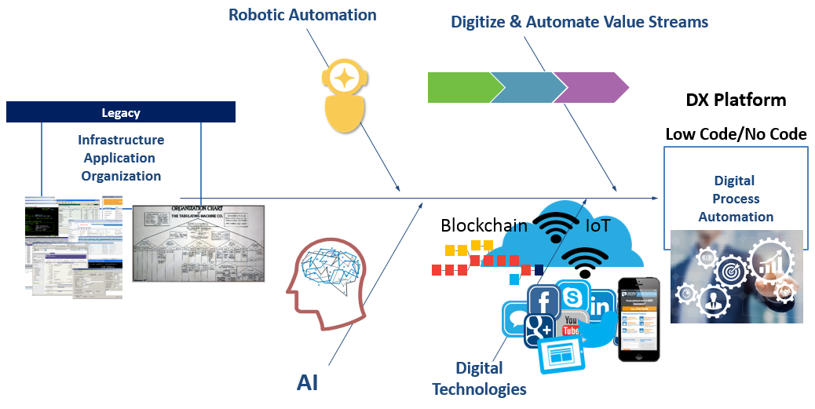
Digital Technologies such as Social, Mobile, Cloud, Internet of Things, Blockchain, Artificial Intelligence, and Robotic Process Automation have each had their share of influence in the evolution of robust DX solutions – especially the ones empowered through emerging Intelligent Automation DPA platforms. The new digital-era business process platforms now incorporate Low Code/No Code capabilities to support Citizen Developers. The transformation is now realized through the speed of digitization and automation of end-to-end value streams – through DPA.
The richness of the digital technologies and the empowerment emanating from Low Code/No Code development accentuates the importance of methodologies and best practices.
The four methodologies described here are not orthogonal. They are interdependent with continuous feedback. They need to be coalesced in robust end-to-end continuous innovation initiatives that realize the potential of autonomic enterprises in motion.
Design Thinking Methodology
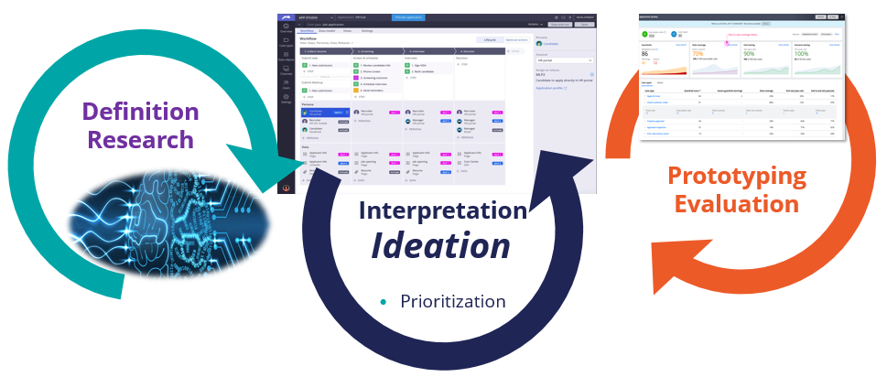
We covered Design Thinking Methodology in a previous post, where we elaborated on the Prioritization of innovation projects. Design Thinking is not a one-and-done methodology. Sometimes organizations have a workshop for Design Thinking, and that becomes the end of it. The approach espoused here is to make Design Thinking – especially ideation for innovation and then Prioritization – continuous.
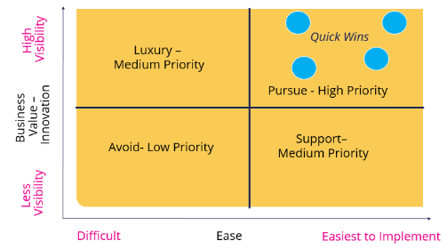
The output of Design Thinking processes is a backlog of “Quick Wins” or “Low Hanging Fruit” DX Projects that feed to the Agile Methodology – for development and delivery. The Prioritization balances ease of implementation with business value:
- Business Value: How important is the innovation project to the business stakeholders? Some KPI’s (Key Performance Indicators) include increased revenue, operational excellence for cost reduction, regulatory compliance, and customer experience optimization.
- Ease and Complexity: Every DPA innovation project candidate will require integration with systems of record or other emerging technologies such as IoT or Blockchain. There are also other considerations, such as UX design, scalability, security, and privacy requirements. Each of these factors impacts the overall complexity of the implementation.
Agile Methodology DX Solutions
The second iteration is, in some ways, the core innovative application development or delivery methodology. Ideally, business, IT, and Operations stakeholders collaborate leveraging the various capabilities of the DPA platform and continuously iterating for multiple releases. With a methodology such as Scrum, the stakeholders can provide feedback and, in fact, in some cases might even decide to release the current version – sometimes even ahead of schedule – as they might deem it good enough for production.

In Scrum, you will have a prioritized product backlog—a list of business and technical features that need to be implemented. The DPA platform supports the iterations as you are building the DPA solution. Each of these iterations is mapped onto DPA elements, such as business rules for risk, approval cases, integration, UI, and other implementation assets. Ideally, the Scrum team includes members from business, IT, and operations. With agile iterations in each sprint or even daily Scrum, the stakeholders – especially the business – have direct visibility and access to the solution that is being built.
DevOps Methodology
“DevOps” stands for Development and Operations. The main business goal of DevOps methodology is rapid, high-quality, and continuous iterations towards deployment. The output of an Agile Scrum methodology (Development) needs to be “hardened” for production and deployed for customers with high quality in all areas – including security, reliability, and performance. With conventional and manual approaches, the “hardening” could take weeks or even months, thus reducing the impact of the innovation for the end customer. This clearly illustrates the importance of all phases of the methodologies to be aligned in speed and efficiencies.
DevOps techniques and methodologies increase the frequency of deployment of solutions or services. DevOps is really an extension of the Agile methodology that increases the collaboration between the development and operation teams. There are several tools that are leveraged in DevOps, such as Jenkins for Continuous Integration and Continuous Delivery. The “integration” here pertains to the incremental code or solution changes that are integrated to a shared repository. These need to go through various types of testing, especially unit testing. In the “delivery” stage, the objective is to accelerate moving and productizing the application or development changes to production deployment, without sacrificing quality. DevOps tooling includes the automation of the overall build and delivery process, as illustrated here.
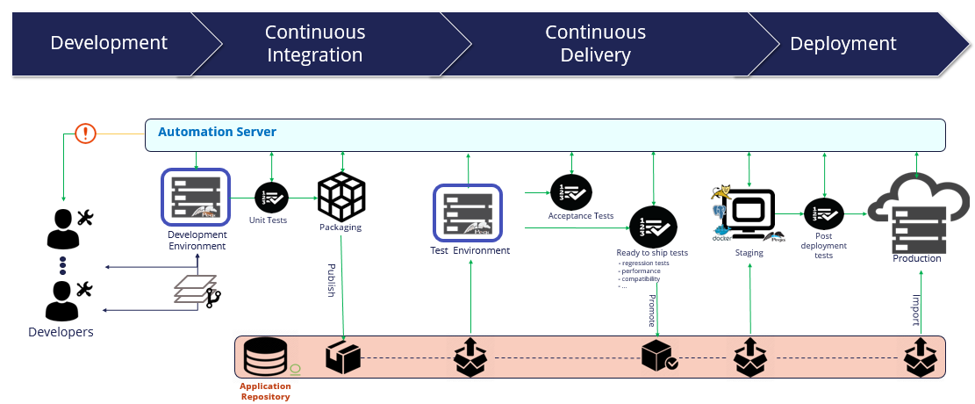
Operational Excellence (Real-Time Lean Six Sigma) Methodology
Once a product is delivered and deployed through Agile and DevOps, it is not the end of the digital transformation journey for that product. The prioritization in Design Thinking identifies a backlog of Quick Wins. The most important dimension in identifying Quick Wins is the business value. There are measures that are typically captured in Key Performance Indicators (KPIs) that need to be monitored to make sure the objectives for the improvement were achieved.
In addition to Continuous Integration and Continuous Delivery, there needs to be Continuous Improvement for measurable business objectives.

This is where Operational Excellence Methodology comes in. Of all the four methodologies, it is the one that often gets the least attention. In some sense, it is the most important. We have been – and continue to be – on the Operational Excellence path: especially through well-established Lean Six Sigma methodologies (see Chapter 8 of iBPM the Next Wave). Another excellent treatment of this methodology for DPA is presented in the paper “Operational Excellence with Digital Process Automation,” which is a chapter in the book Intelligent Automation. Continuous Improvement involves:
- Process efficiency in planning and deploying innovations: Plan
- Process efficiency in automated execution: Do.
- Process efficiency in process monitoring and improvement: Check
- Adjust process efficiency through re-use and specialization: Act
Bringing it Together: DX Competency Center
The previous sections summarized four iterative and continuous methodologies that all share a common objective: Digital Transformation. There is an overall meta-sequence from identifying low hanging fruit for innovative DX projects or products through Design Thinking, to iterative Agile practices to develop and build products or services, to DevOps for continuous integration and delivery, to post-production assessment of business objectives through operational excellence disciplines.
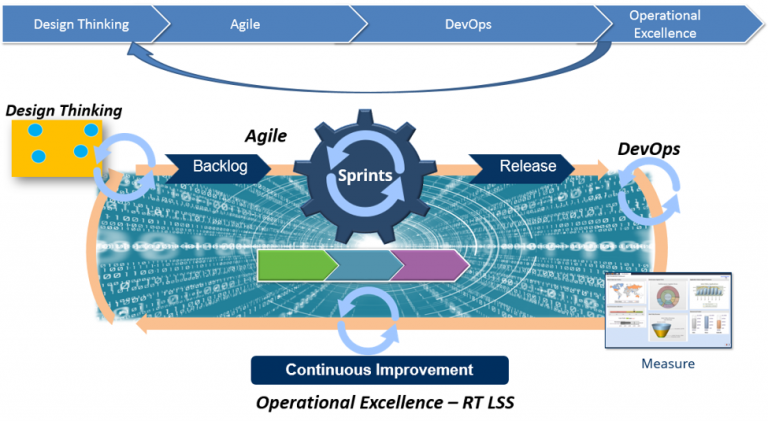
The interplay, transitions, and meta-iterations between these four methodologies are complex. Ignoring any aspect of these methodologies adversely impacts Digital Transformation.
These methodologies are not orthogonal or separated. Agile and DevOps are being coalesced and integrated. Operational Excellence disciplines – especially with Real-Time Lean Six Sigma measures and techniques need to also be assimilated in the DNA of DX practices. Design Thinking drives the dynamic backlog, and it too should be part of the overall meta-methodology – not a sperate or one-and-done workshop (which is often the case). To make this real, methodology siloes need to be avoided.
As much as possible, the processes of the methodologies themselves, as well as the governance for methodology best practices, need to be digitized and automated.
Enter DX Competency Centers (aka Centers of Excellence). There are four main functions of an effective DX Competency Center:
- Enablement: The onboarding and training of team members for DX: with talents and responsibilities for all four methodologies.
- Continuous Review of DX Projects: Project selection, design review, and expert services
- Governance: The governance for the adoption of automation best practices, methodologies (agile) and guardrails to guide team constituents
- Re-Use: The creation and management of reusable assets: process fragments, case types, business rules, analytical models, UI, integration assets, etc.
Governing and managing four iterative methodologies that are intertwined for Digital Transformation is not an easy task. The DX Competency Center needs to be funded and empowered with executive sponsorship.
Yes, DX IA with four methodologies is complex, but the results are tremendous!




